Treatment of Motor Oil-Contaminated Soil with Green Surfactant Using a Mobile Remediation System
Abstract
:1. Introduction
2. Materials and Methods
2.1. Materials
2.2. Biobased Surfactant
2.3. Production of Microbial Surfactant (Biosurfactant)
2.4. Commercial Biosurfactant Formulation
2.5. Construction of the Concrete Mixer-Type Mobile Soil Remediation System (MSRS)
- Cylindrical tank with circular opening, driven by a logic system (source, motor and rotary axis), which promote a rotational displacement of the tank around the rotor axis.
- A basket added inside the drum, with specific mesh (0.053 mm/μm).
- Addition of the components of the mixture (contaminated soil + surfactant) inside the basket. The soil is contaminated after mixing the contaminant (engine oil) with soil, in the proportion of 100 g of soil to 10 g of engine oil. This mixture is inserted through a manual shovel inside the basket.
- Addition of a specific volume of surfactant, which submerges the mixture and, due to the rotation of the tank, washes the contaminated soil.
2.6. Soils Selected for Removal Tests
2.7. Conditions of Application of Surfactants and Soil Washing in the MSRS
- The types of surfactants were chosen based on the comparison of removal efficiency.
- The contaminant concentration values and the chosen soils. Soil contamination with engine motor oil was carried out by manually saturating 100 g of soil contained in a beaker with 10 g of engine oil previously weighted for level −1 and 20 g of engine oil for level +1. Level −1 of soil mass (100 g) was also based on a previous study [13], while level +1 (250 g) was chosen to study the MSRS ability to remove larger quantities of soil. These levels will be explained in detail below.
- In the analysis of the mixture rotation time, two different time intervals were considered (10 and 20 min) in such a way that it was possible to identify what happens to the system in regard to homogenization.
- Rotation speed was tested at 2 different levels, 50 and 100 rpm [13], based mainly on recommended speed limits when using the Permanent Magnet Motor (Bosch CEP F 006 WM0 310) DC 24V 46W.
- Surfactant volumes were defined from observations made during the MSRS operation, and the volumes of 500 and 600 mL were sufficient to cover the soil inside the equipment, promoting a greater probability of washing and removal of the contaminant.
- The minimum volume for the contaminated soil to be covered by the surfactant was 500 mL. Surfactant dilution aimed to evaluate the possibility of using less product. Thus, it was decided to use the pure surfactant and the surfactant diluted with water (1:1, v/v).
- The variation in contaminant concentration aimed to evaluate the removal capacity under different contamination conditions using four types of soils (sand, beach sand, silt and clay).
- Lower energy costs and greater removal productivity are considered fundamental positive aspects both for treatment of contaminated environments and for scale-up necessary for industrial application [17].
- The range of tank inclination angle was established from preliminary experiments with the MSRS, taking into account the angles that generated a greater coverage of the soil contaminated by the surfactant.
- After consecutive MSRS tests, the basket that exhibited a good soil retention capacity, with consecutive permeability of the contaminant plus surfactant, had Mesh 0.053 mm/μm.
2.8. Soils Characterization
2.9. Quantification of the Oil Removed
2.10. Statistical Analysis
3. Results and Discussion
3.1. Construction of the Mobile Soil Remediation System
3.2. Application of Surfactants in Mobile Soil Remediation System
3.2.1. 28-4 Fractional Factorial Design
ST × SV + 0.00796 ST × MRT + 0.007718 ST × SD,
3.2.2. 22 Full Factorial Design
3.2.3. Response Surface Methodology (RSM): Central Composite Rotational Design (CCRD)
3.3. Application of Surfactants in the Removal of Motor Oil Adsorbed on Soils
4. Conclusions
Author Contributions
Funding
Data Availability Statement
Acknowledgments
Conflicts of Interest
References
- Sarubbo, L.A.; Silva, M.d.G.C.; Durval, I.J.B.; Bezerra, K.G.O.; Ribeiro, B.G.; Silva, I.A.; Twigg, M.S.; Banat, I.M. Biosurfactants: Production, properties, applications, trends, and general perspectives. Biochem. Eng. J. 2022, 181, 108377. [Google Scholar] [CrossRef]
- Razek, N.H.A.; Michieka, N.M. OPEC and non-OPEC production, global demand, and the financialization of oil. Res. Int. Bus. Financ. 2019, 50, 201–225. [Google Scholar] [CrossRef]
- Rocha e Silva, N.M.P.; Meira, H.M.; Almeida, F.C.G.; Soares da Silva, R.d.C.F.; Almeida, D.G.; Luna, J.M.; Rufino, R.D.; Santos, V.A.; Sarubbo, L.A. Natural surfactants and their applications for heavy oil removal in industry. Sep. Purif. Rev. 2019, 48, 267–281. [Google Scholar] [CrossRef]
- Sales da Silva, I.G.; Almeida, F.C.G.d.; Rocha e Silva, N.M.P.d; Casazza, A.A.; Converti, A.; Sarubbo, L.A. Soil bioremediation: Overview of technologies and trends. Energies 2020, 13, 4664. [Google Scholar] [CrossRef]
- Almeida, D.G.D.; Soares Da Silva, R.d.C.F.; Luna, J.M.; Rufino, R.D.; Santos, V.A.; Banat, I.M.; Sarubbo, L.A. Biosurfactants: Promising molecules for petroleum biotechnology advances. Front. Microbiol. 2016, 7, 1718. [Google Scholar] [CrossRef] [PubMed] [Green Version]
- Al-Raoush, R.; Ngueleu, S.; Rezanezhad, F.; Van Cappellen, P. Groundwater pollution by petroleumderived contaminants in coastal semiarid environment. Energy Environ. 2018, 2018, EEPD709. [Google Scholar] [CrossRef]
- Guo, S.; Li, F.; Li, P.; Wang, S.; Zhao, Q.; Li, G.; Wu, B.; Tai, P. Study on remediation technologies of organic and heavy metal contaminated soils. In Twenty Years of Research and Development on Soil Pollution and Remediation in China; Springer: Singapore, 2018; pp. 703–723. [Google Scholar] [CrossRef]
- Ossai, I.C.; Ahmed, A.; Hassan, A.; Hamid, F.S. Remediation of soil and water contaminated with petroleum hydrocarbon: A review. Environ. Technol. Innov. 2020, 17, 100526. [Google Scholar] [CrossRef]
- Liu, G.; Zhong, H.; Yang, X.; Liu, Y.; Shao, B.; Liu, Z. Advances in applications of rhamnolipids biosurfactant in environmental remediation: A review. Biotechnol. Bioeng. 2018, 115, 796–814. [Google Scholar] [CrossRef]
- Sar, P.; Ghosh, A.; Scarso, A.; Saha, B. Surfactant for better tomorrow: Applied aspect of surfactant aggregates from laboratory to industry. Res. Chem. Intermed. 2019, 45, 6021–6041. [Google Scholar] [CrossRef]
- Farias, C.B.B.; Almeida, F.C.G.; Silva, I.A.; Souza, T.C.; Meira, H.M.; Soares da Silva, R.d.C.F.; Luna, J.M.; Santos, V.A.; Converti, A.; Banat, I.M.; et al. Production of green surfactants: Market prospects. Electron. J. Biotechnol. 2021, 51, 28–39. [Google Scholar] [CrossRef]
- De, S.; Malik, S.; Ghosh, A.; Saha, R.; Saha, B. A review on natural surfactants. RSC Adv. 2015, 5, 65757–65767. [Google Scholar] [CrossRef]
- da Silva, I.G.S.; de Almeida, F.C.G.; da Rocha e Silva, N.M.P.; de Oliveira, J.T.R.; Converti, A.; Sarubbo, L.A. Application of green surfactants in the remediation of soils contaminated by hydrocarbons. Processes 2021, 9, 1666. [Google Scholar] [CrossRef]
- Hu, Y.; Ju, L.-K. Purification of lactonic sophorolipids by crystallization. J. Biotechnol. 2001, 87, 263–272. [Google Scholar] [CrossRef] [PubMed]
- Ranjan, R.; Kumar, D.; Kundu, M.; Chandra Moi, S. A critical review on classification of materials used in 3D printing process. Mater. Today Proc. 2022, 61, 43–49. [Google Scholar] [CrossRef]
- Khidir, T.C. Designing, remodeling and analyzing the blades of portable concrete mixture. Int. J. Mech. Eng. Robot. Res. 2018, 7, 674–678. [Google Scholar] [CrossRef]
- Nižetić, S.; Djilali, N.; Papadopoulos, A.; Rodrigues, J.J.P.C. Smart technologies for promotion of energy efficiency, utilization of sustainable resources and waste management. J. Clean. Prod. 2019, 231, 565–591. [Google Scholar] [CrossRef]
- Montgomery, D.C.; Wiley, J. Design and Analysis of Experiments, 8th ed.; John Wiley & Sons: Hoboken, NJ, USA, 2013; ISBN 978-1118146927. [Google Scholar]
- Box, G.E.P.; Hunter, J.S. Multi-factor experimental designs for exploring response surfaces. Ann. Math. Stat. 1957, 28, 195–241. [Google Scholar] [CrossRef]
- Mateus, N.; Barbin, D.; Conagin, A. Feasibility of using the central composite design. Acta Sci. Technol. 2001, 23, 1537–1546. [Google Scholar]
- Diamond, W.J. Practical Experiment Designs: For Engineers and Scientists, 3rd ed.; John Wiley & Sons: New York, NY, USA, 2001; ISBN 978-0471390541. [Google Scholar]
- ABNT, Associação Brasileira de Normas Técnicas. NBR 7181; Solos: Análise Granulométrica Conjunta; ABNT: Rio de Janeiro, Brazil, 1984. [Google Scholar]
- ABNT, Associação Brasileira de Normas Técnicas. NBR 6459; Solos: Determinação do Limite de Liquidez; ABNT: Rio de Janeiro, Brazil, 1984. [Google Scholar]
- ABNT, Associação Brasileira de Normas Técnicas. NBR 7180; Solos: Determinação do Limite de Plasticidade; ABNT: Rio de Janeiro, Brazil, 1984. [Google Scholar]
- ABNT, Associação Brasileira de Normas Técnicas. NBR 6508; Massa Específica dos Grãos dos Solos; ABNT: Rio de Janeiro, Brazil, 1984. [Google Scholar]
- ABNT, Associação Brasileira de Normas Técnicas. NBR 7182; Solo Ensaio de Compactação.; ABNT: Rio de Janeiro, Brazil, 1986. [Google Scholar]
- De Medeiros, A.D.M.; Da Silva Junior, C.J.G.; De Amorim, J.D.P.; Durval, I.J.B.; De Santana Costa, A.F.; Sarubbo, L.A. Oily wastewater treatment: Methods, challenges, and trends. Processes 2022, 10, 743. [Google Scholar] [CrossRef]
- Andromalos, K.; Ruffing, D. The Magazine of the Deep Foundations Institute; 2014; pp. 55–58. Available online: https://www.researchgate.net/publication/274029950_Soil_Mixing_in_Contaminated_Soils (accessed on 11 November 2022).
- Ruffing, D.; Andromalos, K.; Payne, D.R.; Schindler, R.M. An overview of U.S. industry practice for soil mixing in contaminated soil. In Proceedings of the Deep Mixing 2021, Online Conference, 1,3,8,10,15,17 June 2021. [Google Scholar]
- Niedz, R.P. Fractional factorial designs: An underutilized tool for rapid in vitro system development. In Doubled Haploid Technology; Methods in Molecular Biology Book Series; Humana: New York, NY, USA, 2021; pp. 23–45. [Google Scholar] [CrossRef]
- Jankovic, A.; Chaudhary, G.; Goia, F. Designing the design of experiments (DOE). An investigation on the influence of different factorial designs on the characterization of complex systems. Energy Build. 2021, 250, 111298. [Google Scholar] [CrossRef]
- Moussavi, G.; Khosravi, R.; Farzadkia, M. Removal of petroleum hydrocarbons from contaminated groundwater using an electrocoagulation process: Batch and continuous experiments. Desalination 2011, 278, 288–294. [Google Scholar] [CrossRef]
- Chachina, S.B.; Voronkova, N.A.; Baklanova, O.N. Biological remediation of the engine lubricant oil-contaminated soil with three kinds of earthworms, Eisenia fetida, Eisenia andrei, Dendrobena veneta, and a mixture of microorganisms. Procedia Eng. 2015, 113, 113–123. [Google Scholar] [CrossRef] [Green Version]
- Karthick, A.; Roy, B.; Chattopadhyay, P. A review on the application of chemical surfactant and surfactant foam for remediation of petroleum oil contaminated soil. J. Environ. Manag. 2019, 243, 187–205. [Google Scholar] [CrossRef]
- Kalvandi, S.; Garousin, H.; Pourbabaee, A.A.; Farahbakhsh, M. The release of petroleum hydrocarbons from a saline-sodic soil by the new biosurfactant-producing strain of Bacillus sp. Sci. Rep. 2022, 12, 19770. [Google Scholar] [CrossRef] [PubMed]
- Eras-Muñoz, E.; Farré, A.; Sánchez, A.; Font, X.; Gea, T. Microbial biosurfactants: A review of recent environmental applications. Bioeng. 2022, 13, 12365–12391. [Google Scholar] [CrossRef]
- Wang, J.; Wan, W. Application of desirability function based on neural network for optimizing biohydrogen production process. Int. J. Hydrogen Energy 2009, 34, 1253–1259. [Google Scholar] [CrossRef]
- Myers, R.H.; Montgomery, D.C.; Anderson-Cook, C.M. Response Surface Methodology: Process and Product Optimization Using Designed Experiments, 4th ed.; John Wiley & Sons: New York, NY, USA, 2016; ISBN 978-1-118-91601-8. [Google Scholar]
- Abdel-Farid, I.B.; Marghany, M.R.; Rowezek, M.M.; Sheded, M.G. Effect of salinity stress on growth and metabolomic profiling of Cucumis sativus and Solanum lycopersicum. Plants 2020, 9, 1626. [Google Scholar] [CrossRef]
- Chaprão, M.J.; Ferreira, I.N.S.; Correa, P.F.; Rufino, R.D.; Luna, J.M.; Silva, E.J.; Sarubbo, L.A. Application of bacterial and yeast biosurfactants for enhanced removal and biodegradation of motor oil from contaminated sand. Electron. J. Biotechnol. 2015, 18, 471–479. [Google Scholar] [CrossRef] [Green Version]
- Skempton, A.W. The colloidal “activity” of clays. Sel. Pap. Soil Mech. 1984, 1, 60–64. [Google Scholar] [CrossRef]
- Pastore, E.L.; Fontes, R.M. Caracterização e classificação dos solos. In Geologia de Engenharia; Oliveira, A.M.S., Brito, S.N.A., Eds.; Associação Brasileira de Geologia de Engenharia: São Paulo, Brazil, 1998; pp. 199–210. ISBN 8572700021. [Google Scholar]
- Mao, X.; Jiang, R.; Xiao, W.; Yu, J. Use of surfactants for the remediation of contaminated soils: A review. J. Hazard. Mater. 2015, 285, 419–435. [Google Scholar] [CrossRef]
- Rufino, R.D.; Luna, J.M.; Marinho, P.H.C.; Farias, C.B.B.; Ferreira, S.R.M.; Sarubbo, L.A. Removal of petroleum derivative adsorbed to soil by biosurfactant Rufisan produced by Candida lipolytica. J. Pet. Sci. Eng. 2013, 109, 117–122. [Google Scholar] [CrossRef]
- Jimoh, A.A.; Lin, J. Biosurfactant: A new frontier for greener technology and environmental sustainability. Ecotoxicol. Environ. Saf. 2019, 184, 109607. [Google Scholar] [CrossRef] [PubMed]
- Silva, S.N.R.L.; Farias, C.B.B.; Rufino, R.D.; Luna, J.M.; Sarubbo, L.A. Glycerol as substrate for the production of biosurfactant by Pseudomonas aeruginosa UCP0992. Colloids Surf. B Biointerfaces 2010, 79, 174–183. [Google Scholar] [CrossRef]
- Durval, I.; Rufino, R.; Sarubbo, L. Biosurfactant as an environmental remediation agent: Toxicity, formulation, and application in the removal of petroderivate in sand and rock walls. Biointerface Res. Appl. Chem. 2021, 12, 34–48. [Google Scholar] [CrossRef]




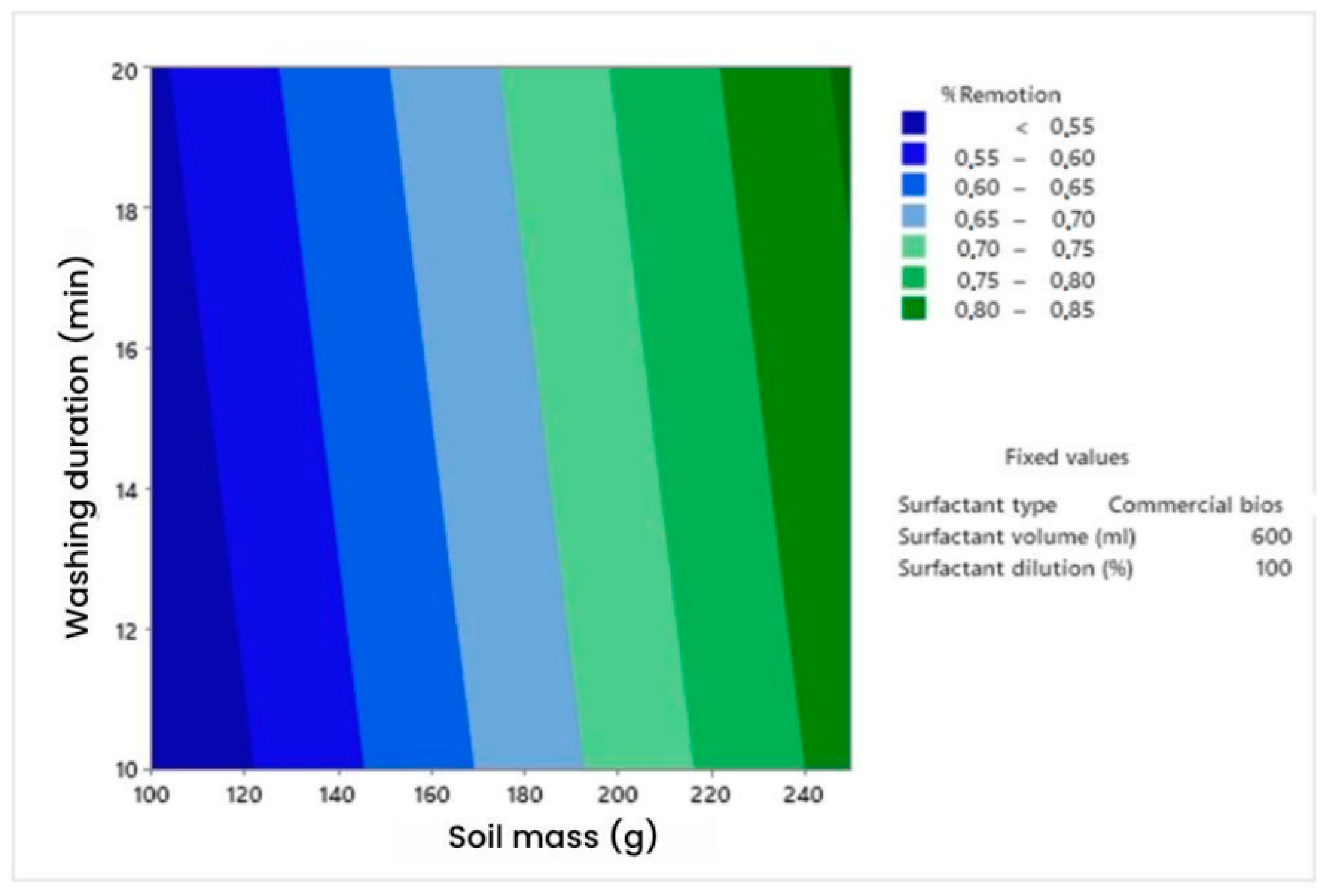

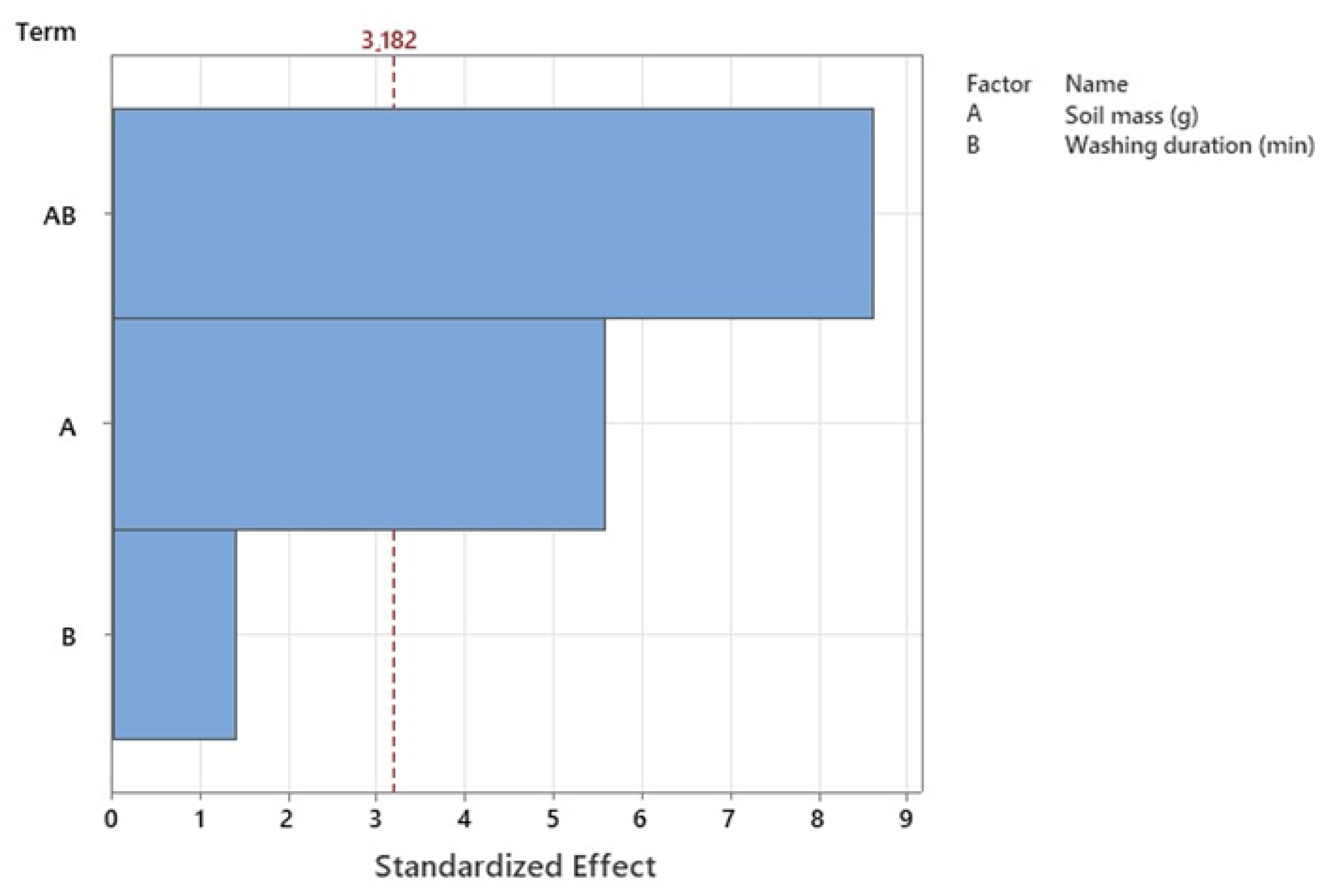
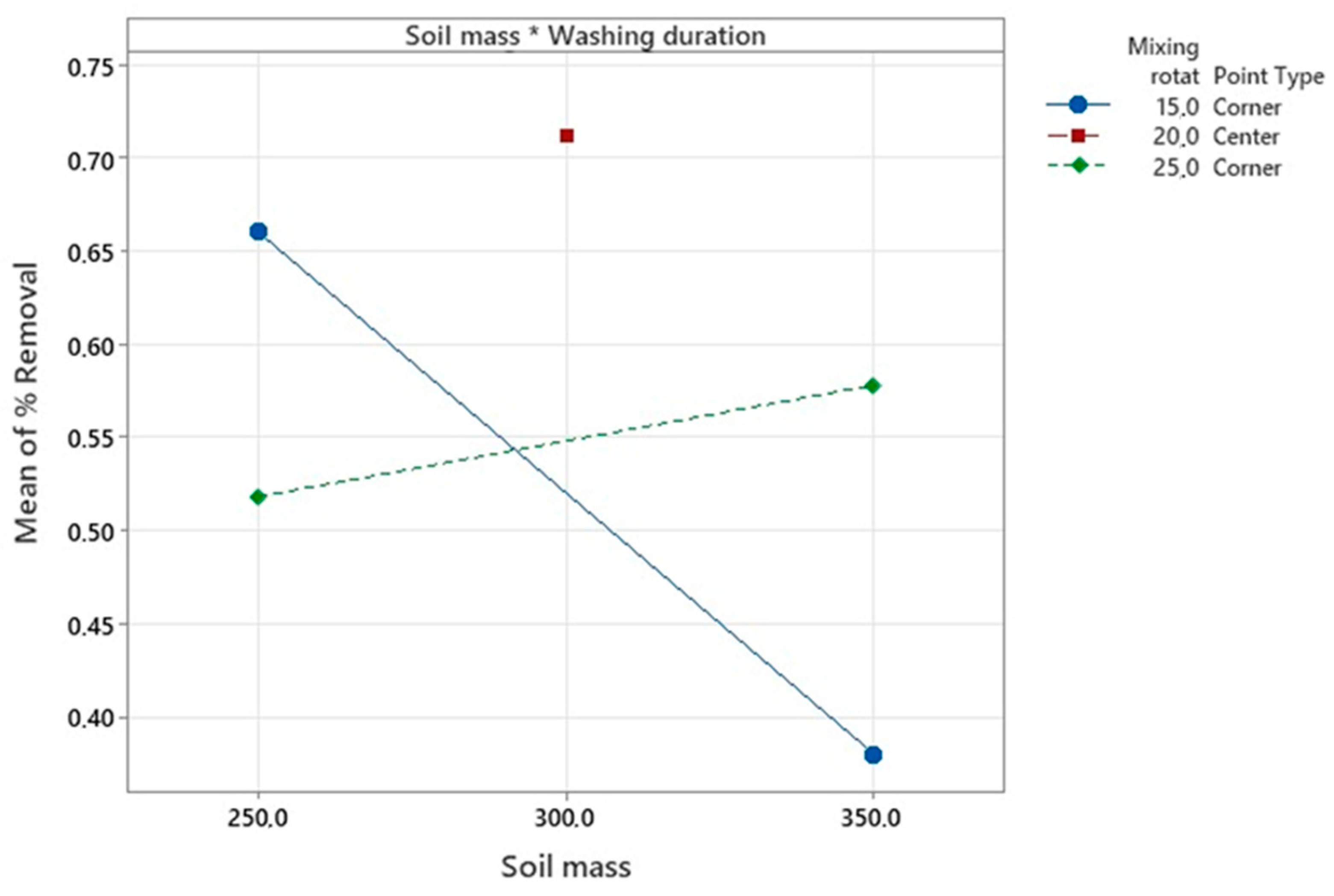

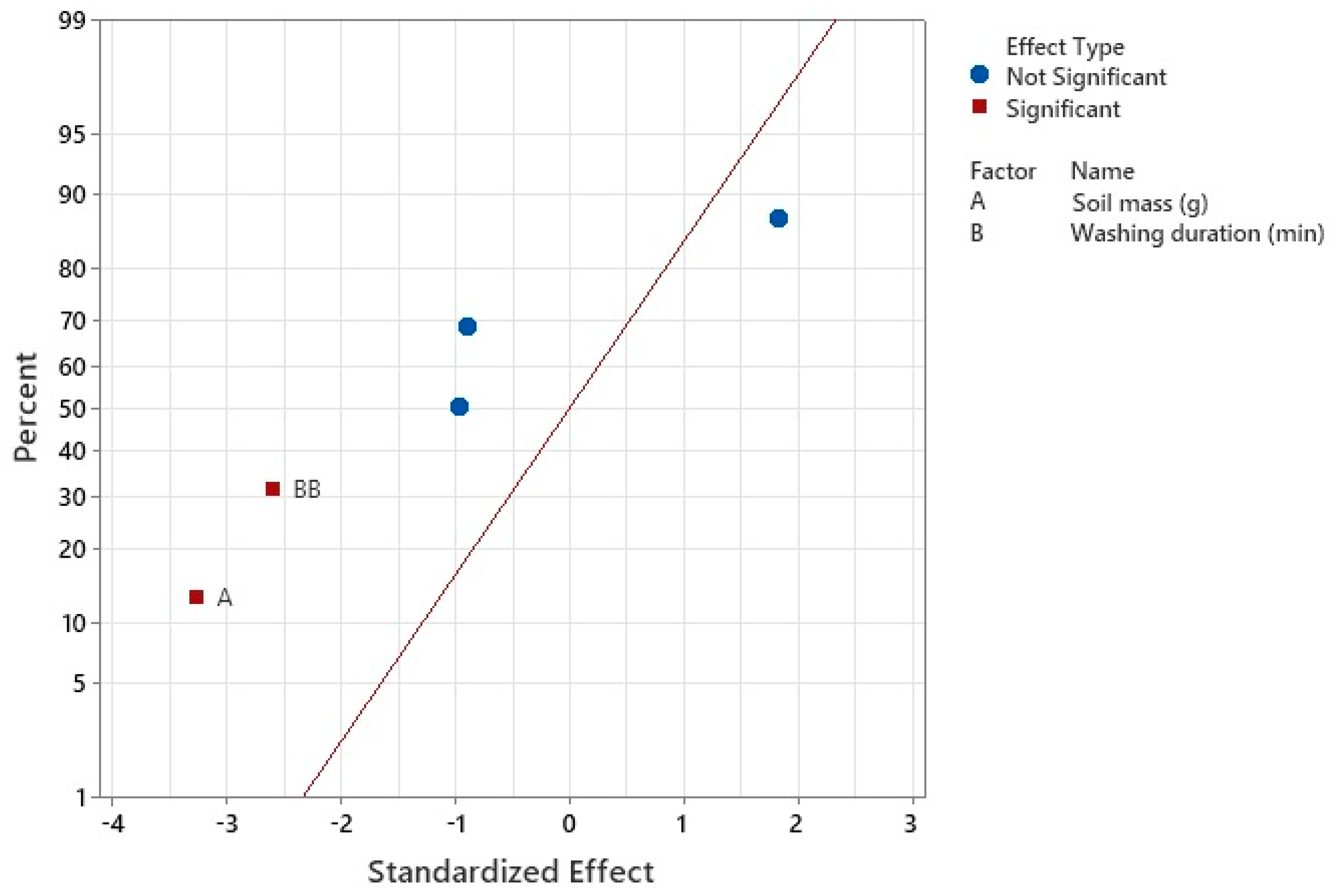
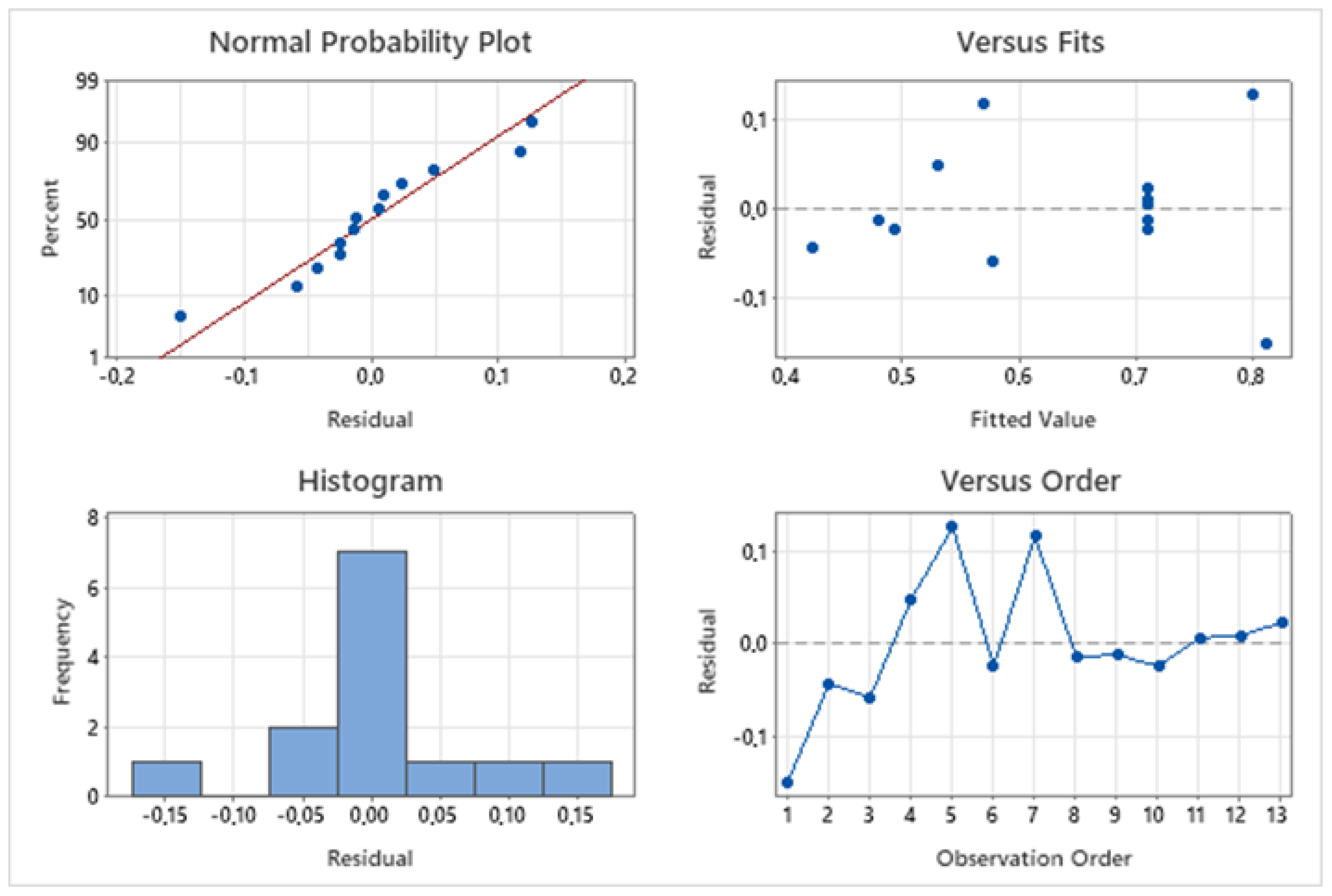
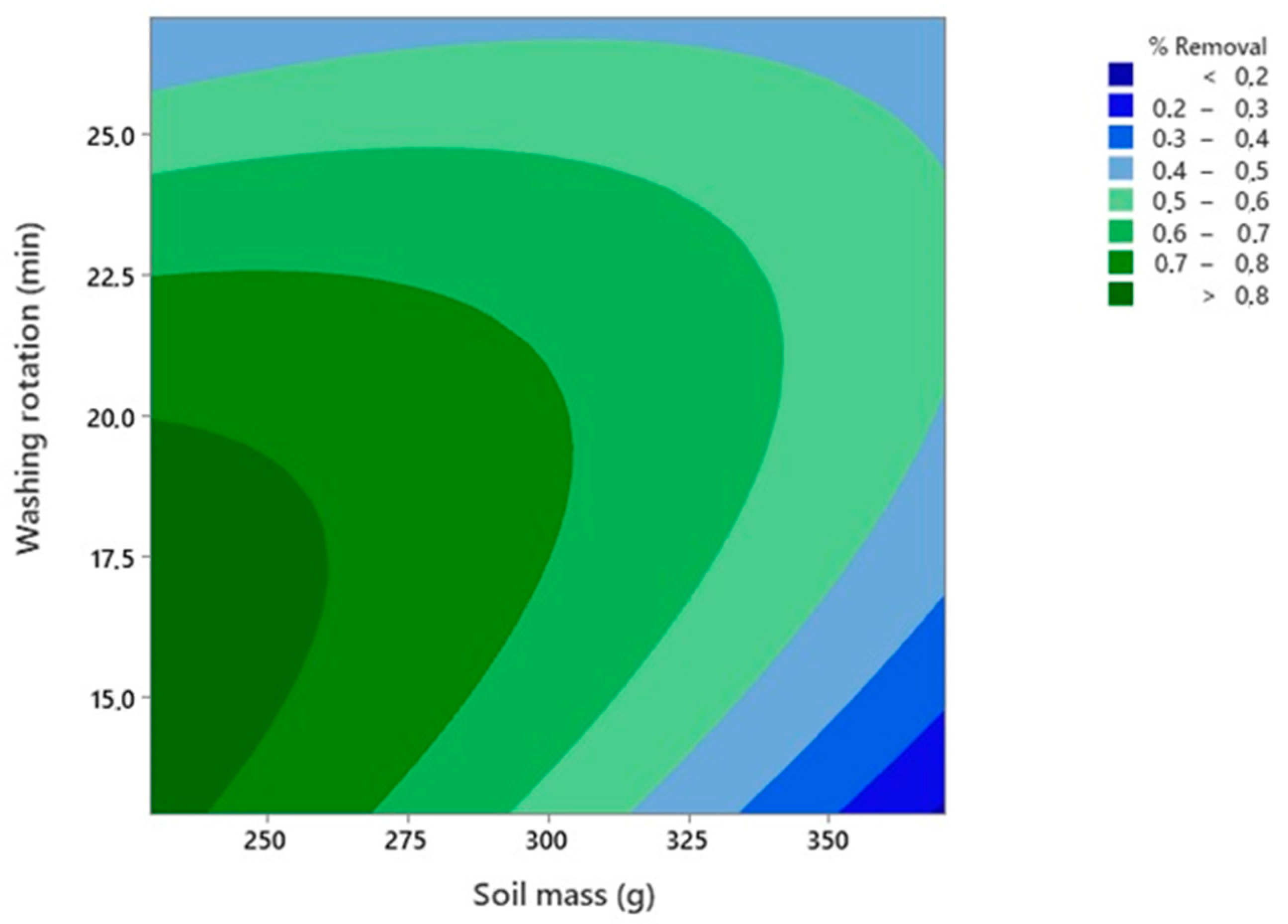


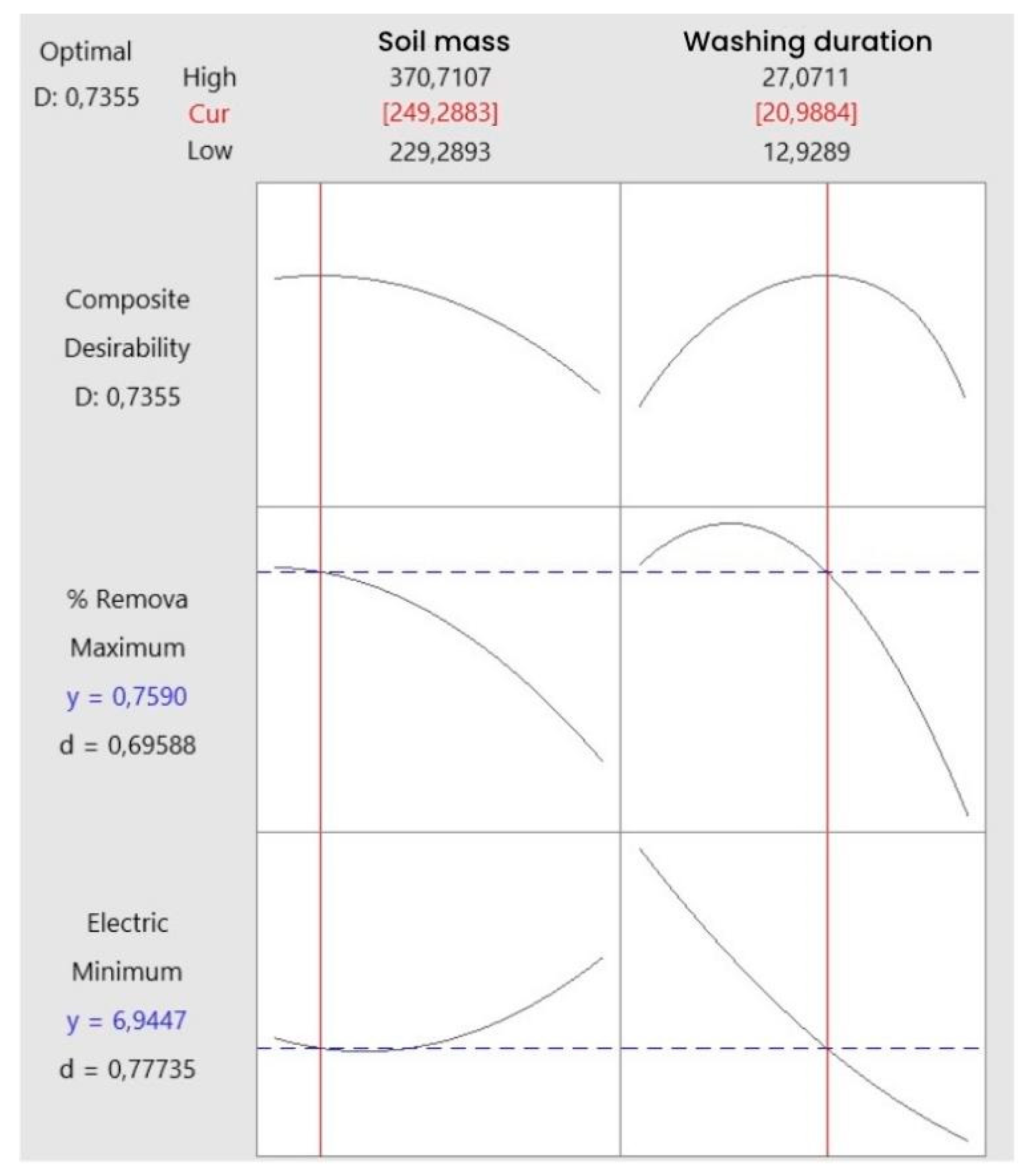


| Independent Variables | Level (−1) | Level (+1) |
|---|---|---|
| Surfactant type | Biobased surfactant | Commercial biosurfactant |
| Surfactant volume (mL) | 500 | 600 |
| Surfactant dilution (%) * | 50 | 100 |
| Contaminant concentration (%) | 10 | 20 |
| Four soil types | Sandy and Sea Sand | Silty and Clay |
| Soil mass (g) | 100 | 250 |
| Washing duration (min) | 10 | 20 |
| Tank tilt angle (°) | 40 | 60 |
| Mixing speed (rpm) | 25 | 50 |
| Seven types of baskets (mm/μm) | 2, 1, 0.5, 0.3, 0.25 | 0.212, 0.053 |
| Independent Variables | Level (−1) | Level (+1) |
|---|---|---|
| Surfactant type | Biobased surfactant | Commercial biosurfactant |
| Surfactant volume (mL) | 500 | 600 |
| Surfactant dilution (%) | 50 | 100 |
| Contaminant concentration (%) | 10 | 20 |
| Soil mass (g) | 100 | 250 |
| Washing duration (min) | 10 | 20 |
| Tank tilt angle (°) | 40 | 60 |
| Mixing speed (rpm) | 25 | 50 |
| AB + CG + DH + EF + (…) |
| AC + BG + DF + EH + (…) |
| AD + BH + CF + EG + (…) |
| AE + BF + CH + DG + (…) |
| AF + BE + CD + GH + (…) |
| AG + BC + DE + FH + (…) |
| AH + BD + CE + FG + (…) |
| Independent Variables | Level | |
|---|---|---|
| −1 | +1 | |
| Soil mass (g) | 250 | 350 |
| Washing duration (min) | 15 | 25 |
| Independent Variables | Level | ||||
|---|---|---|---|---|---|
| −1.414 | −1 | 0 | +1 | +1.414 | |
| Soil mass (g) | 229.289 | 250 | 300 | 350 | 370.711 |
| Washing duration (min) | 12.928 | 15 | 20 | 25 | 27.071 |
| Parameter | Soil | |||
|---|---|---|---|---|
| Beach sand | Sandy | Silty | Clayey | |
| Granulometry (%) | ||||
| Sand | 98 | 56 | 30 | 26 |
| Silt | 1 | 5 | 39 | 30 |
| Clay | 1 | 39 | 31 | 44 |
| % Liquidity–plasticity (LP) < 2 μm | 0.6 | 37 | 45 | 53 |
| Consistency | ||||
| Liquidity limit (%) | 0 | 47 | 71 | 66 |
| Plasticity index (PI) (%) | 0 | 10 | 26 | 13 |
| Ia 1 | 0 | 0.29 | 1.0 | 0.59 |
| Compaction | ||||
| Optimal moisture content (%) | 6.5 | 34 | 26 | 22 |
| μdmax 2 (kN/m3) | 14.7 | 26.5 | 27.6 | 26.8 |
| Unified Soil Classification | SP * | SC * | MH * | CH * |
| Runs | Removal (%) | Electrical Power (Watt) |
|---|---|---|
| 1 | 37.52 | 6300 |
| 2 | 73.90 | 10,584 |
| 3 | 80.20 | 19,032 |
| 4 | 55.60 | 18,788 |
| 5 | 19.83 | 16,836 |
| 6 | 8.17 | 22,448 |
| 7 | 3.27 | 9324 |
| 8 | 45.17 | 8316 |
| 9 | 9.67 | 19,276 |
| 10 | 45.89 | 16,836 |
| 11 | 60.94 | 7560 |
| 12 | 9.32 | 10,332 |
| 13 | 68.98 | 9324 |
| 14 | 67.98 | 8694 |
| 15 | 48.00 | 14,640 |
| 16 | 78.80 | 24,888 |
Disclaimer/Publisher’s Note: The statements, opinions and data contained in all publications are solely those of the individual author(s) and contributor(s) and not of MDPI and/or the editor(s). MDPI and/or the editor(s) disclaim responsibility for any injury to people or property resulting from any ideas, methods, instructions or products referred to in the content. |
© 2023 by the authors. Licensee MDPI, Basel, Switzerland. This article is an open access article distributed under the terms and conditions of the Creative Commons Attribution (CC BY) license (https://creativecommons.org/licenses/by/4.0/).
Share and Cite
Silva, I.G.S.d.; Pappalardo, J.R.; Rocha e Silva, N.M.P.d.; Converti, A.; Almeida, F.C.G.d.; Sarubbo, L.A. Treatment of Motor Oil-Contaminated Soil with Green Surfactant Using a Mobile Remediation System. Processes 2023, 11, 1081. https://doi.org/10.3390/pr11041081
Silva IGSd, Pappalardo JR, Rocha e Silva NMPd, Converti A, Almeida FCGd, Sarubbo LA. Treatment of Motor Oil-Contaminated Soil with Green Surfactant Using a Mobile Remediation System. Processes. 2023; 11(4):1081. https://doi.org/10.3390/pr11041081
Chicago/Turabian StyleSilva, Israel Gonçalves Sales da, Juliano Rodrigues Pappalardo, Nathália Maria Padilha da Rocha e Silva, Attilio Converti, Fabíola Carolina Gomes de Almeida, and Leonie Asfora Sarubbo. 2023. "Treatment of Motor Oil-Contaminated Soil with Green Surfactant Using a Mobile Remediation System" Processes 11, no. 4: 1081. https://doi.org/10.3390/pr11041081








